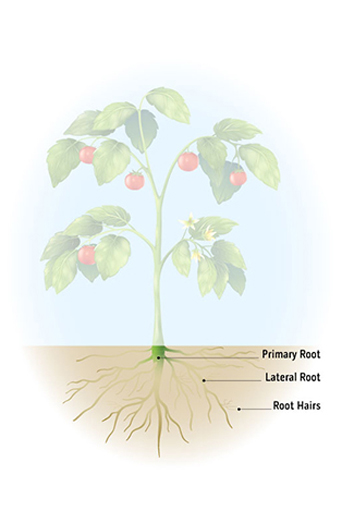Origin: a Latin derivative
meaning "Gift of the Earth."
Part 2: Plant Structure—Roots (Rhizome)

Roots are a plant’s major absorption organs and are responsible for extracting the necessary water and nutrients from the soil. Often, the roots extend deep into the ground allowing water and nutrients to be withdrawn from well below the soil surface. Not only do the roots help protect a plant when water is sparse, they also help plants survive when they are forced to compete with nearby plants for resources. Another important role of the roots is to anchor the plant into the ground, preventing it from sliding, moving, or being pulled out.
The roots are composed of an intricate branched system to allow for maximum absorption. All rooting plants consist of a network of one main root called the primary root and many smaller root branches called lateral roots. The primary root is the first to grow during seed germination and will eventually thicken and become the plant’s principal site of absorption. Extending from this main root are many smaller lateral roots that are covered in millions of tiny root hairs. This branched network increases the surface area exposed to the soil, allowing the plant to absorb as much water and nutrients as possible.
There are two mechanisms that allow water to get from the outside of the root to the core of the plant. The first uses a water potential gradient to move water across the root hair membrane and into the cells themselves. The second way involves travel through the intracellular spaces and along cell walls to reach the plant’s core. Here, the water can be carried to the rest of the plant using a system of conducting tissues that extend throughout the plant’s structure.
Rhizomes are a modified subterranean main stem that grow below the soil surface that are often thickened by food reserves. They are distinguished from true roots by possessing nodes and internodes and chlorophyll-free scale-like leaves. Rhizomes send out roots and shoots from the nodes. Rhizomatous plants are hops, irises, asparagus violets etc. Ginger oil is produced by the distillation of its rhizomes.
Stolons which are of-shoots of the existing stem are creeping horizontal plant root-like stems that grow either above or just below the soil surface. They take root at their tip or nodes and form new plants often referred to as daughter plants. Plants propagated this way are peppermint, spearmint and strawberry.





